Zexu Pan
FunAudio-ASR Technical Report
Sep 15, 2025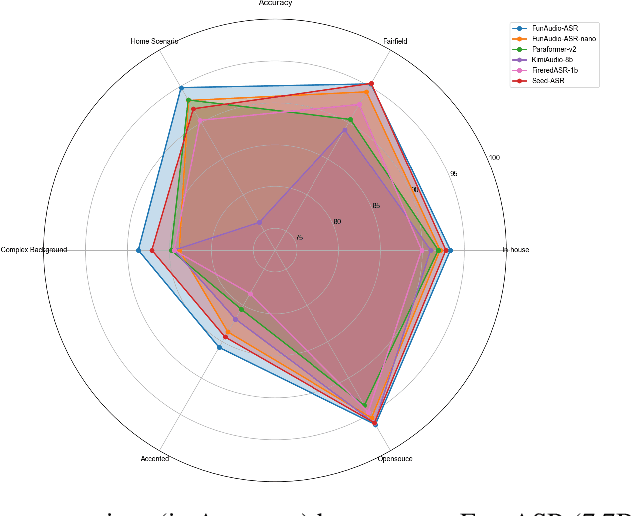

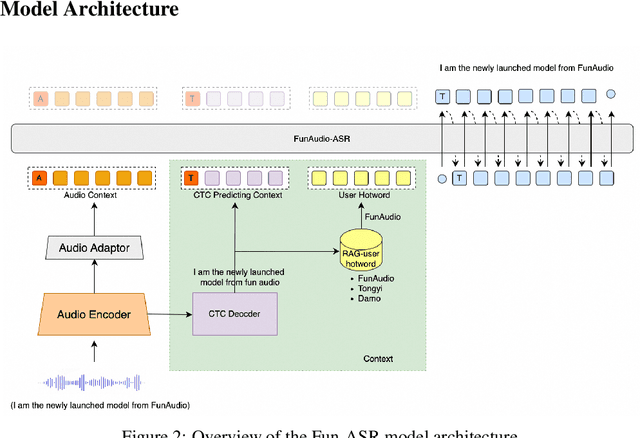

Abstract:In recent years, automatic speech recognition (ASR) has witnessed transformative advancements driven by three complementary paradigms: data scaling, model size scaling, and deep integration with large language models (LLMs). However, LLMs are prone to hallucination, which can significantly degrade user experience in real-world ASR applications. In this paper, we present FunAudio-ASR, a large-scale, LLM-based ASR system that synergistically combines massive data, large model capacity, LLM integration, and reinforcement learning to achieve state-of-the-art performance across diverse and complex speech recognition scenarios. Moreover, FunAudio-ASR is specifically optimized for practical deployment, with enhancements in streaming capability, noise robustness, code-switching, hotword customization, and satisfying other real-world application requirements. Experimental results show that while most LLM-based ASR systems achieve strong performance on open-source benchmarks, they often underperform on real industry evaluation sets. Thanks to production-oriented optimizations, FunAudio-ASR achieves SOTA performance on real application datasets, demonstrating its effectiveness and robustness in practical settings.
ClearerVoice-Studio: Bridging Advanced Speech Processing Research and Practical Deployment
Jun 24, 2025Abstract:This paper introduces ClearerVoice-Studio, an open-source, AI-powered speech processing toolkit designed to bridge cutting-edge research and practical application. Unlike broad platforms like SpeechBrain and ESPnet, ClearerVoice-Studio focuses on interconnected speech tasks of speech enhancement, separation, super-resolution, and multimodal target speaker extraction. A key advantage is its state-of-the-art pretrained models, including FRCRN with 3 million uses and MossFormer with 2.5 million uses, optimized for real-world scenarios. It also offers model optimization tools, multi-format audio support, the SpeechScore evaluation toolkit, and user-friendly interfaces, catering to researchers, developers, and end-users. Its rapid adoption attracting 3000 GitHub stars and 239 forks highlights its academic and industrial impact. This paper details ClearerVoice-Studio's capabilities, architectures, training strategies, benchmarks, community impact, and future plan. Source code is available at https://github.com/modelscope/ClearerVoice-Studio.
Plug-and-Play Co-Occurring Face Attention for Robust Audio-Visual Speaker Extraction
May 27, 2025Abstract:Audio-visual speaker extraction isolates a target speaker's speech from a mixture speech signal conditioned on a visual cue, typically using the target speaker's face recording. However, in real-world scenarios, other co-occurring faces are often present on-screen, providing valuable speaker activity cues in the scene. In this work, we introduce a plug-and-play inter-speaker attention module to process these flexible numbers of co-occurring faces, allowing for more accurate speaker extraction in complex multi-person environments. We integrate our module into two prominent models: the AV-DPRNN and the state-of-the-art AV-TFGridNet. Extensive experiments on diverse datasets, including the highly overlapped VoxCeleb2 and sparsely overlapped MISP, demonstrate that our approach consistently outperforms baselines. Furthermore, cross-dataset evaluations on LRS2 and LRS3 confirm the robustness and generalizability of our method.
Causal Self-supervised Pretrained Frontend with Predictive Code for Speech Separation
Apr 03, 2025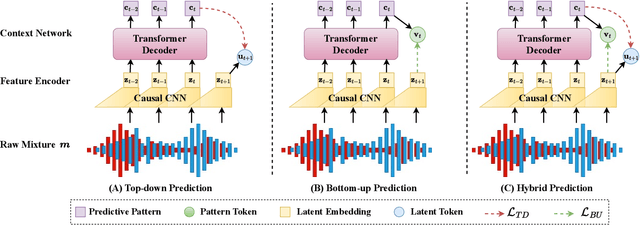
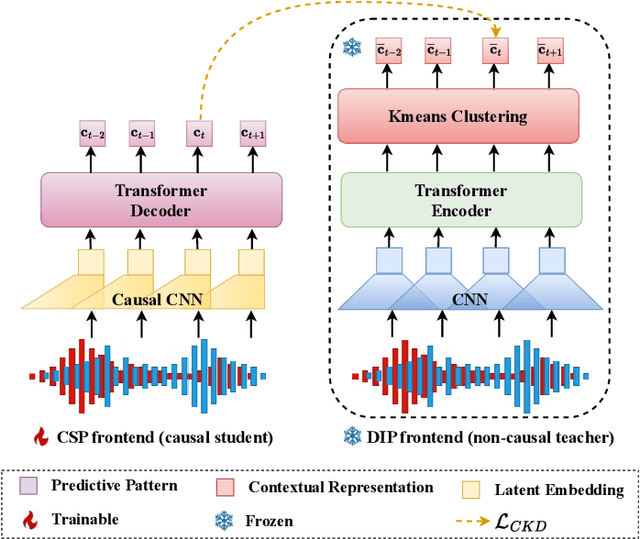
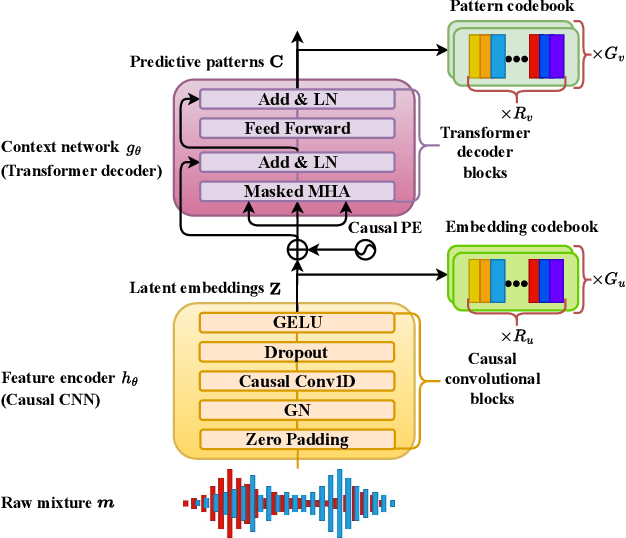
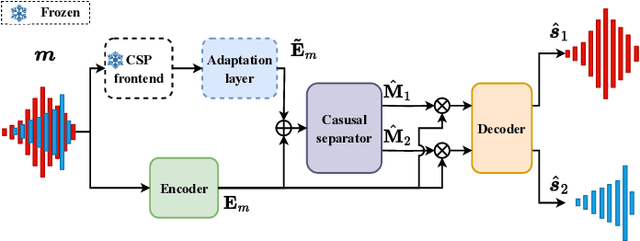
Abstract:Speech separation (SS) seeks to disentangle a multi-talker speech mixture into single-talker speech streams. Although SS can be generally achieved using offline methods, such a processing paradigm is not suitable for real-time streaming applications. Causal separation models, which rely only on past and present information, offer a promising solution for real-time streaming. However, these models typically suffer from notable performance degradation due to the absence of future context. In this paper, we introduce a novel frontend that is designed to mitigate the mismatch between training and run-time inference by implicitly incorporating future information into causal models through predictive patterns. The pretrained frontend employs a transformer decoder network with a causal convolutional encoder as the backbone and is pretrained in a self-supervised manner with two innovative pretext tasks: autoregressive hybrid prediction and contextual knowledge distillation. These tasks enable the model to capture predictive patterns directly from mixtures in a self-supervised manner. The pretrained frontend subsequently serves as a feature extractor to generate high-quality predictive patterns. Comprehensive evaluations on synthetic and real-world datasets validated the effectiveness of the proposed pretrained frontend.
Context-Aware Two-Step Training Scheme for Domain Invariant Speech Separation
Mar 16, 2025Abstract:Speech separation seeks to isolate individual speech signals from a multi-talk speech mixture. Despite much progress, a system well-trained on synthetic data often experiences performance degradation on out-of-domain data, such as real-world speech mixtures. To address this, we introduce a novel context-aware, two-stage training scheme for speech separation models. In this training scheme, the conventional end-to-end architecture is replaced with a framework that contains a context extractor and a segregator. The two modules are trained step by step to simulate the speech separation process of an auditory system. We evaluate the proposed training scheme through cross-domain experiments on both synthetic and real-world speech mixtures, and demonstrate that our new scheme effectively boosts separation quality across different domains without adaptation, as measured by signal quality metrics and word error rate (WER). Additionally, an ablation study on the real test set highlights that the context information, including phoneme and word representations from pretrained SSL models, serves as effective domain invariant training targets for separation models.
HiFi-SR: A Unified Generative Transformer-Convolutional Adversarial Network for High-Fidelity Speech Super-Resolution
Jan 17, 2025Abstract:The application of generative adversarial networks (GANs) has recently advanced speech super-resolution (SR) based on intermediate representations like mel-spectrograms. However, existing SR methods that typically rely on independently trained and concatenated networks may lead to inconsistent representations and poor speech quality, especially in out-of-domain scenarios. In this work, we propose HiFi-SR, a unified network that leverages end-to-end adversarial training to achieve high-fidelity speech super-resolution. Our model features a unified transformer-convolutional generator designed to seamlessly handle both the prediction of latent representations and their conversion into time-domain waveforms. The transformer network serves as a powerful encoder, converting low-resolution mel-spectrograms into latent space representations, while the convolutional network upscales these representations into high-resolution waveforms. To enhance high-frequency fidelity, we incorporate a multi-band, multi-scale time-frequency discriminator, along with a multi-scale mel-reconstruction loss in the adversarial training process. HiFi-SR is versatile, capable of upscaling any input speech signal between 4 kHz and 32 kHz to a 48 kHz sampling rate. Experimental results demonstrate that HiFi-SR significantly outperforms existing speech SR methods across both objective metrics and ABX preference tests, for both in-domain and out-of-domain scenarios (https://github.com/modelscope/ClearerVoice-Studio).
Conditional Latent Diffusion-Based Speech Enhancement Via Dual Context Learning
Jan 17, 2025Abstract:Recently, the application of diffusion probabilistic models has advanced speech enhancement through generative approaches. However, existing diffusion-based methods have focused on the generation process in high-dimensional waveform or spectral domains, leading to increased generation complexity and slower inference speeds. Additionally, these methods have primarily modelled clean speech distributions, with limited exploration of noise distributions, thereby constraining the discriminative capability of diffusion models for speech enhancement. To address these issues, we propose a novel approach that integrates a conditional latent diffusion model (cLDM) with dual-context learning (DCL). Our method utilizes a variational autoencoder (VAE) to compress mel-spectrograms into a low-dimensional latent space. We then apply cLDM to transform the latent representations of both clean speech and background noise into Gaussian noise by the DCL process, and a parameterized model is trained to reverse this process, conditioned on noisy latent representations and text embeddings. By operating in a lower-dimensional space, the latent representations reduce the complexity of the generation process, while the DCL process enhances the model's ability to handle diverse and unseen noise environments. Our experiments demonstrate the strong performance of the proposed approach compared to existing diffusion-based methods, even with fewer iterative steps, and highlight the superior generalization capability of our models to out-of-domain noise datasets (https://github.com/modelscope/ClearerVoice-Studio).
Improved Feature Extraction Network for Neuro-Oriented Target Speaker Extraction
Jan 03, 2025



Abstract:The recent rapid development of auditory attention decoding (AAD) offers the possibility of using electroencephalography (EEG) as auxiliary information for target speaker extraction. However, effectively modeling long sequences of speech and resolving the identity of the target speaker from EEG signals remains a major challenge. In this paper, an improved feature extraction network (IFENet) is proposed for neuro-oriented target speaker extraction, which mainly consists of a speech encoder with dual-path Mamba and an EEG encoder with Kolmogorov-Arnold Networks (KAN). We propose SpeechBiMamba, which makes use of dual-path Mamba in modeling local and global speech sequences to extract speech features. In addition, we propose EEGKAN to effectively extract EEG features that are closely related to the auditory stimuli and locate the target speaker through the subject's attention information. Experiments on the KUL and AVED datasets show that IFENet outperforms the state-of-the-art model, achieving 36\% and 29\% relative improvements in terms of scale-invariant signal-to-distortion ratio (SI-SDR) under an open evaluation condition.
pTSE-T: Presentation Target Speaker Extraction using Unaligned Text Cues
Nov 05, 2024



Abstract:TSE aims to extract the clean speech of the target speaker in an audio mixture, thus eliminating irrelevant background noise and speech. While prior work has explored various auxiliary cues including pre-recorded speech, visual information (e.g., lip motions and gestures), and spatial information, the acquisition and selection of such strong cues are infeasible in many practical scenarios. Unlike all existing work, in this paper, we condition the TSE algorithm on semantic cues extracted from limited and unaligned text content, such as condensed points from a presentation slide. This method is particularly useful in scenarios like meetings, poster sessions, or lecture presentations, where acquiring other cues in real-time is challenging. To this end, we design two different networks. Specifically, our proposed TPE fuses audio features with content-based semantic cues to facilitate time-frequency mask generation to filter out extraneous noise, while another proposal, namely TSR, employs the contrastive learning technique to associate blindly separated speech signals with semantic cues. The experimental results show the efficacy in accurately identifying the target speaker by utilizing semantic cues derived from limited and unaligned text, resulting in SI-SDRi of 12.16 dB, SDRi of 12.66 dB, PESQi of 0.830 and STOIi of 0.150, respectively. Dataset and source code will be publicly available. Project demo page: https://slideTSE.github.io/.
Speech Separation with Pretrained Frontend to Minimize Domain Mismatch
Nov 05, 2024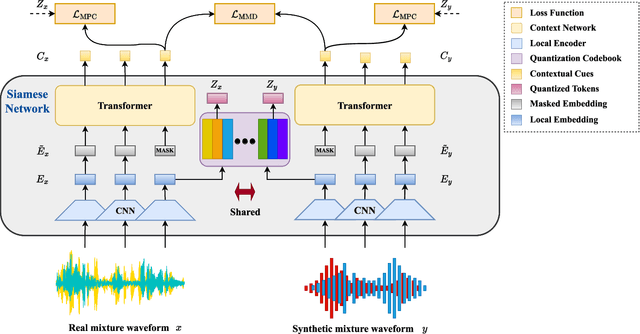
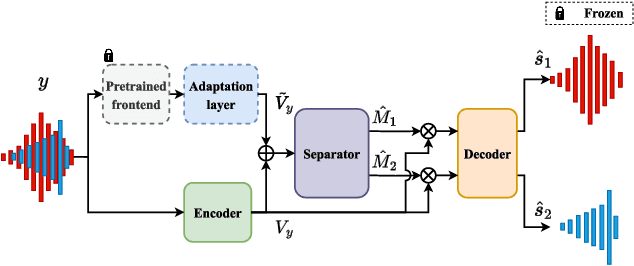
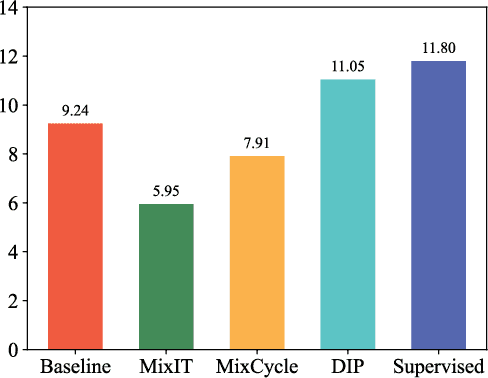
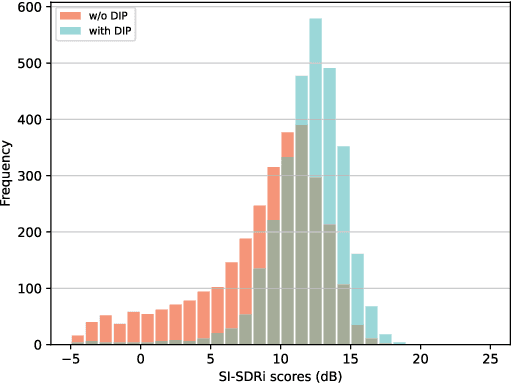
Abstract:Speech separation seeks to separate individual speech signals from a speech mixture. Typically, most separation models are trained on synthetic data due to the unavailability of target reference in real-world cocktail party scenarios. As a result, there exists a domain gap between real and synthetic data when deploying speech separation models in real-world applications. In this paper, we propose a self-supervised domain-invariant pretrained (DIP) frontend that is exposed to mixture data without the need for target reference speech. The DIP frontend utilizes a Siamese network with two innovative pretext tasks, mixture predictive coding (MPC) and mixture invariant coding (MIC), to capture shared contextual cues between real and synthetic unlabeled mixtures. Subsequently, we freeze the DIP frontend as a feature extractor when training the downstream speech separation models on synthetic data. By pretraining the DIP frontend with the contextual cues, we expect that the speech separation skills learned from synthetic data can be effectively transferred to real data. To benefit from the DIP frontend, we introduce a novel separation pipeline to align the feature resolution of the separation models. We evaluate the speech separation quality on standard benchmarks and real-world datasets. The results confirm the superiority of our DIP frontend over existing speech separation models. This study underscores the potential of large-scale pretraining to enhance the quality and intelligibility of speech separation in real-world applications.
* IEEE/ACM Transactions on Audio, Speech, and Language Processing
 Add to Chrome
Add to Chrome Add to Firefox
Add to Firefox Add to Edge
Add to Edge